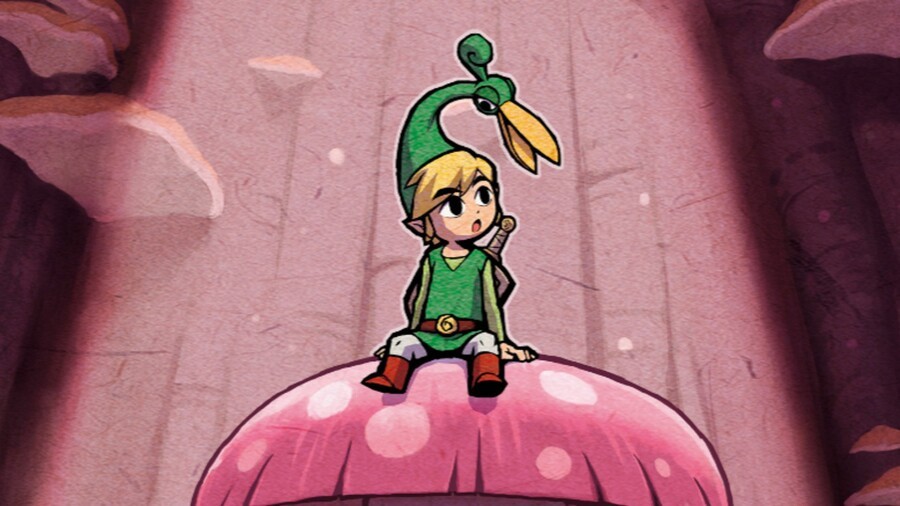
To celebrate the 35th anniversary of The Legend of Zelda, we're running a series of features looking at a specific aspect — a theme, character, mechanic, location, memory or something else entirely — from each of the mainline Zelda games. Today, Kate graps her (Minish) cap and heads out for a stroll through a familiar landscape made new via a fresh point of view...
I've never completed a Dark Souls game, but I love talking about their design all the same. The premise of a Dark Souls game is often similar across the board: there's something wrong with the world, and you have to clean it up or figure it out somehow. The undercurrent of design, on the other hand, is one of re-orienting yourself and seeing things from a different viewpoint. You will find yourself climbing through maze-like honeycombs of long corridors, swamps, castles and the like, only to emerge again at a place that's so familiar to you that you wonder how you didn't notice that you were walking back there this whole time.
I used to walk through London a lot, so I've experienced this in real life, too. That feeling when you turn a corner and that instant recognition hits you like a train is a wonderful thing, like coming home after a long and tiring day. I would deliberately manufacture my planned walking routes to recreate the feeling of being "lost" — of course, you're never truly lost with a smartphone in your pocket — just so I could have that soothing homecoming moment, over and over again.
The more I walked, the more it happened — when I least expected it, even — and although I can't say that I know London as well as a Hackney cab driver, there are some parts I can identify just by sight. I can even tell you where the closest café is, because what is a walk around London without a hot chocolate to keep you company?
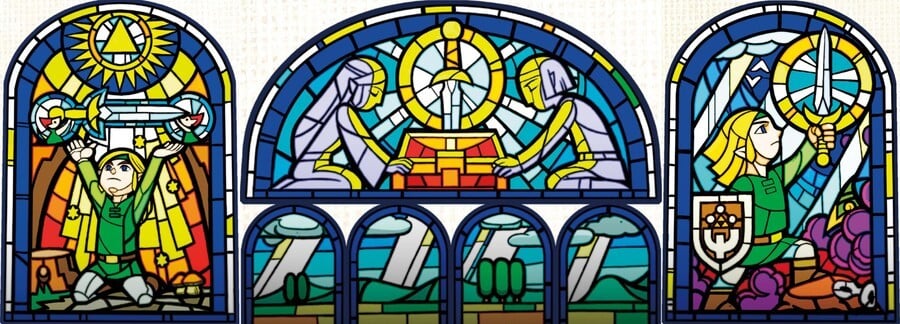
I'm extremely tempted to kick off this piece (er, 300 words in) by boldly declaring that The Legend of Zelda: The Minish Cap is, in fact, a Dark Souls game — which it's not, of course, since it predates FromSoft's series by seven years, but also because it doesn't actually share most of the design philosophies of Dark Souls: the hopelessness of entropy, and the need to keep trying all the same. I will say, though, that the DNA that runs through Minish Cap is more accurately that of a cousin, or step-sibling, to the Dark Souls games. It all comes down to perspective.
The Minish Cap is a game about a talking hat that makes you small. Previous Zelda games at this point have featured instruments, mirrors, and magical swords that turn you into a teen; in 2004, we get a mouthy nightcap. But this gimmick proves to be so much more than its initial pitch, bringing Link into the world of the Picori — tiny little pixie-people who live under the feet of the Hyrulians, who renovate upturned pots and leaves into their homes.
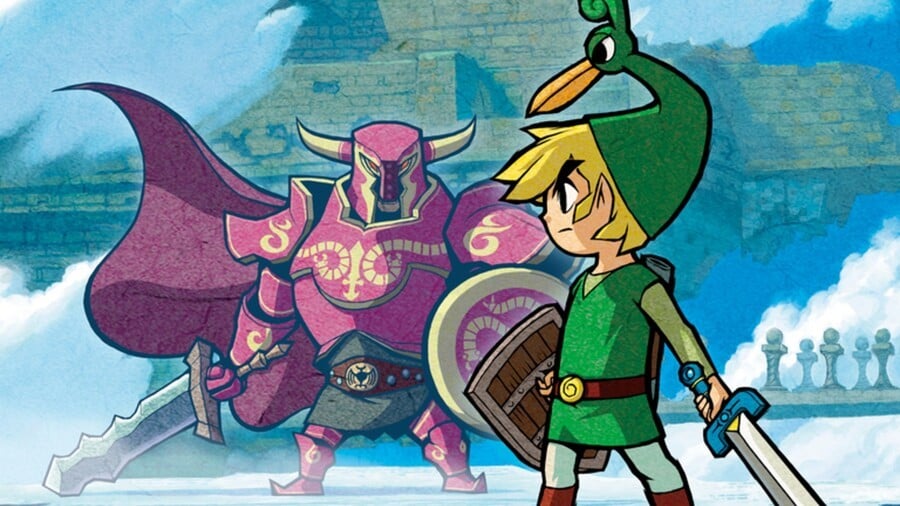
Suddenly, the world is doubled in size, even as Link is shrunk to a fraction of his. A bookcase becomes a ladder, a pair of shoes becomes an impassable object, and light rain becomes deadly deluge of Link-sized droplets. Just like Dark Souls, Link — and the player — are forced to re-orient themselves, and adjust what they know about the world. Never before did anyone particularly question the fact that there were Rupees in pots and grass, but Minish Cap answers the question all the same: 'twas the Picori who hid them there!
Much like Majora's Mask before it, Minish Cap tries new things, with strange new items that have yet to be replicated in the series. Roc's Cape, the garment that lets Link fly, may have been borrowed from the equally-weird Oracle of Seasons (also made by Capcom's dev team, Flagship), and the Gust Jar — which sucks (no, literally) — would go on to appear in Skyward Sword, but the Cane of Pacci and the Kinstone Bag are Minish-only items.

The Kinstone Bag is fairly easy to understand: you find tiny half-medals throughout the game, and search for people who have the other half in order to unlock secrets, new doors, and treasures.
The Cane of Pacci is a little weirder. It's a magical crook that can be used to... flip things over. This power, at first, doesn't seem like that big of a deal — oh, great, now everything is upside down, that helps — but you quickly discover that flipping over certain pots can unlock portals to the Picori realm, that some enemies can be defused by turning them upside down, and that firing the Cane of Pacci at a hole will turn it into a sort of trampoline. I don't know how that makes sense, exactly... but it's cool, so who cares.

Even more brilliantly, the Cane of Pacci ties neatly into The Minish Cap's point: look at things differently, and you may just discover something new. What seemed like a normal pot before is suddenly revealed to be a gate between worlds; holes that previously barred progress are now able to catapult you to new areas.
But The Minish Cap's best moment is its very first boss battle, which, like the Cane of Pacci, flips the player's expectation on its head. Throughout the Zelda series, since Majora's Mask introduced them, the Chuchu in its various colours has been one of the more irritating basic enemies. Although relatively tricky to beat in the very early stages, Link quickly becomes too beefy to bother with fighting these gelatinous goons, unless he needs their Jelly for a recipe. What better boss to convey the new risks and terrors of being small than...
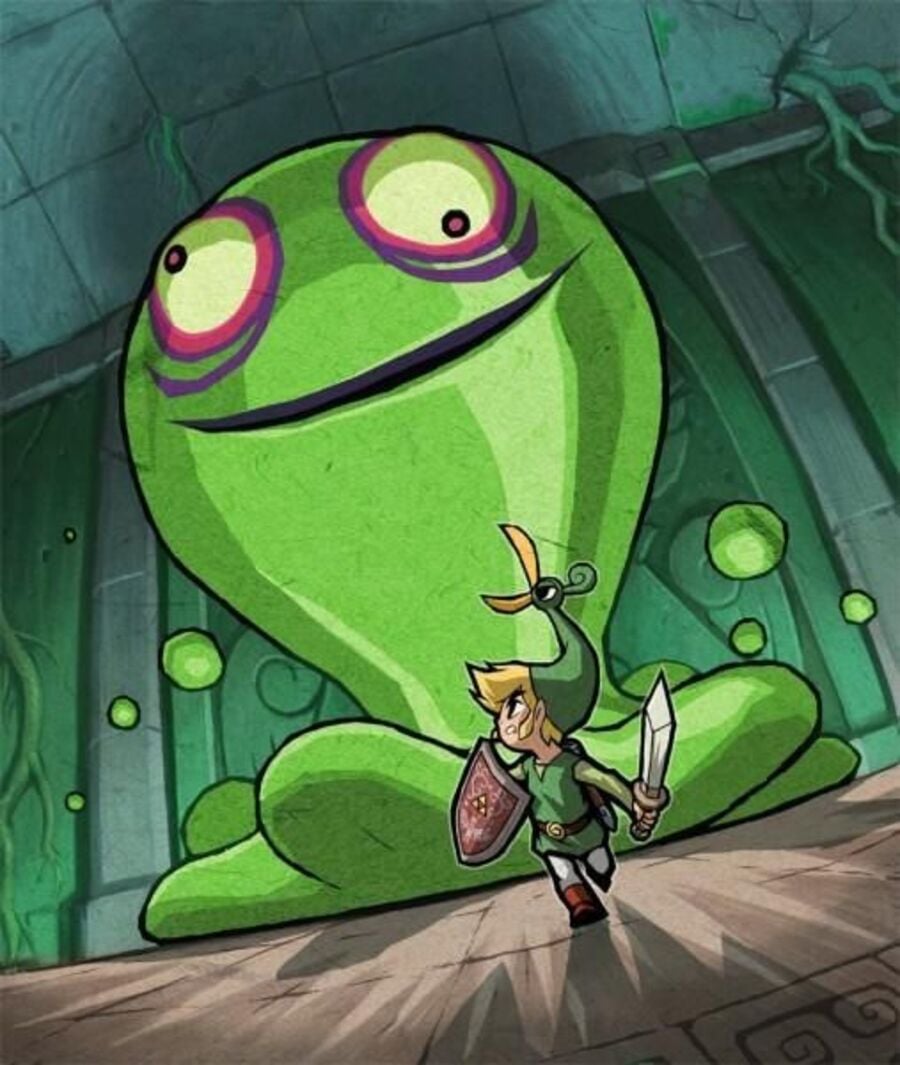
…The Big Green Chuchu. You can't defeat this towering slime the way you normally would, by lazily slashing at it as you run past. This guy is so, so much bigger than you that your sword would hardly make a dent. Instead, you have to use the Gust Jar to slurp away some of his slime, weakening his... neck (?) until his huge head falls over and you can slice him in the eyes.
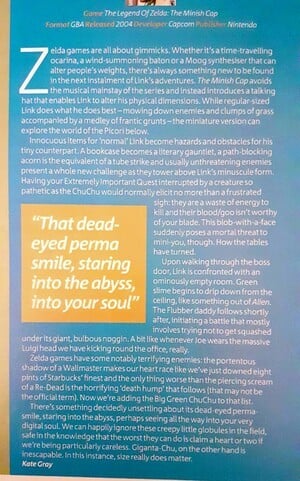
The genius of making an enemy that's so basic that he's barely a threat normally into a fearsome boss is something that I've never really seen again in a Zelda game, but it's so quintessentially Zelda all the same.
I wrote about the Big Green Chuchu when I was the Staff Writer at Official Nintendo Magazine, so if you'll forgive this moment of self-indulgence, here's what I had to say about it back in 2014:
Having your Extremely Important Quest interrupted by a creature so pathetic as the Chuchu would normally elicit no more than a frustrated sigh: they are a waste of energy to kill and their blood/goo isn't worthy of your blade. This blob-with-a-face suddenly poses a mortal threat to mini-you, though. How the tables have turned.
I will note that I also called it "The Flubber Daddy", so, you know, take my words with a pinch of caution. Moving swiftly on...
In Bloodborne — the FromSoft game I've played the most — there's a moment where you come to a gate, and, just like the hundreds of gates you've found before, you laboriously push it open with a heavy creeeak. You think nothing of it, except that you now have access to somewhere new. But a second glance will reveal that this isn't just any gate — this is the very first locked gate you encountered in the game, about twenty hours ago. You had honestly forgotten about it, hadn't you? But here it is, the beginning of the game, a place that was so familiar to me, not least because my Bloodborne tactic is 'grind as much as possible in the starting area so you stand a chance'.
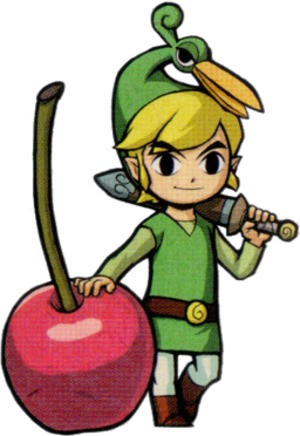
Whoops, I wrote another hundred words on From Software's games in this Minish Cap feature. I'm sorry. But I do have a point, and that point is this: The Minish Cap, just like Bloodborne, can only achieve its sense of altered space through re-contextualising what we think we know. Coming back to a place we recognise is no big deal; I walk into my kitchen multiple times a day and it doesn't blow my mind each time. But if I were on holiday in the Bahamas, and my hotel closet secretly led to my kitchen — now that would be a surprise. And a pretty useful one, since I probably left my sunscreen at home.
The Minish Cap's charming use of everyday items, encounters, and set pieces makes it so incredibly special. A level that takes place in a rotating, hole-filled barrel, a boss that requires you to beat it as full-size Link and then climb inside its brain as tiny Link to destroy the wiring, and the lovable Picori that live inside repurposed shoes and carry needles as canes — all of these things could have easily been just normal dungeons and towns, with stone walls, wood floors, lava and the like. Instead, the developers took inspiration from the world around them, reminding players constantly that, when you're small, everything is new and old at the same time.
So, no, The Minish Cap is not a Dark Souls game. If anything... Dark Souls is a Minish Cap game.





Comments 46
Such a fun portable Zelda title for the GBA. Though it's not A Link to the Past level of epicness, it at least offer a new perspective in the gameplay department. Really love some of the cool little Ocarina of Time, Wind Waker, and Four Sword references litter throughout the game.
The Minish Cap remains my favourite game in the series.
The Mrs even bought me the Ezlo hat as a gift, and then threatened to divorce me for wearing it to pick her up from work.
I love Minish Cap and it’s easily my favorite portable Zelda (unless you count BOTW as a portable Zelda).
Yes, I think it’s better than Link’s Awakening. Fight me.
Still my favorite zelda game by a longshot and one of my favorite games in general (it’s in my top 20)
I like your take. For me it was a total squandering of a fantastic premise, oh to be young and imaginative again. I can see why people like Minish Cap though, it has a lovely tone to the adventure.
Another great Capcom game!
The Minish Cap could've been better but it still was a phenomenal game especially for the altering of perspective. I believe they considered bringing the Picori back for BOTW and letting you shrink but shelved the idea, I hope they revive the idea for BOTW 2.
Zelda Minish Cap is one of the most underrated Zelda games IMO.
Minish Cap has my favorite visuals of any 2D Zelda, everything on the screen just pops so well.
Whenever I think of Zelda music, some versions of tracks from this specific game are the first that start playing in my head. Its artwork is simply the best in the entire series. The game is not PERFECT, but it's hard to miss the overall charm of it. Together with Link's Awakening (any version) easily my favourite top-down Zelda, and 3D or top-down is more a matter of what I want to play in the moment, not one being better than the other.
My all time favorite Zelda.
Love the shot of an old ONM, clearly somebody still has their collection 😂
Easily one of my favorite Zelda games. I bought it when I got my original DS to take advantage of the GBA slot. It was the first Zelda game I'd played in a while so that made it doubly awesome!
I love the Minish Cap! But comparing it to a Dark Souls game? Really?
They have NOTHING in common!!!
I love minish cap, currently replaying it on my 3DS.
@Ghost_of_Hasashi Well. Basically being the Four Sword origin story needed references of that.
But yeah, otherwise.
@nessisonett not me, sadly - Future threw away most of my copies when we moved offices, along with a bunch of merch, various press goodies, and gifts from fans. I still haven't forgiven them.
@KateGray Wow, that’s a real, real shame for them to chuck so many years worth of history. All those fan drawings over the years too. To think how many brands there were under the banner 10 years ago and now it’s what, just PC Gamer left? I only ended up using this site because after ONM went, the forums recommended we went here after that shut down too.
@KateGray
Great article Kate. I think it really captures the wholesome essence of Minish Cap. For me I got Minish Cap as a Christmas present in 2004. I must have been about 13, the game really enthralled me like no other GBA game. It was my first 2D and handheld Zelda and the first 2D Zelda game I finished. I remember Vaati being really difficult at the end of the game.
Luckily if you're a 3ds ambassador this game can be in your library. Still...wish a I had the original box. It's worth money now.
By the way here's two of my articles comparing the n
N64 Zelda's to the 3ds remasters. Hook me up with a job if you can! Half joking lol.
https://www.fovmag.com/ocarina-of-time-original-vs-remake-which-is-better/?amp=1
https://www.fovmag.com/majoras-mask-original-vs-remake-which-is-better/?amp=1
First LoZ game I ever beat. Good times.
You keep the sunscreen in your kitchen?
Having played most of the 2D Zeldas over the years (OG Zelda, LttP, LA remake and almost done with LBW) I have to say that Minish Cap remains my favorite of all of them and the only one I've played through multiple times....really fun game! It is funny...I'd really love a remake/update of the Oracle games, but would really like MC to just be re-released pretty much as-is.
Will have to finish this Zelda one day, think I got about halfway then stuck. I think dark souls is like when music lovers have a kraftwerk phase. I know I did. But for me the dark souls games are in my past and don’t feel the urge to go back. Xxx
One of my favourite Zelda games of all times, this one has incredible charm and plays great - although I have yet to beat the final boss: It's a real doozy.
I am still rooting for a return of some sort, a form of acknowledgement. There is a disturbingly small amount of merch of this game! I would kill for a statue of link with some picori. They're by FAR the cutest characters in any zelda game...
One of the top 3 Zeldas for sure. I really want a Links Awakening style remake only keeping the Wind Waker art style.
I absolutely adored this game... really fond memories of this on GBA.
One of the greatest Zelda for sure. Been daydreaming about a remake for years.
@Trialus
I agree, it has to keep the pixel style. Maybe higher definition and QOL improvements.
I’d like to play this game at some point, but authentic copies are going for $100 on eBay and it just isn’t worth quite that much to me. I’d probably be willing to pay like $50. I don’t have a Wii U for the Virtual Console version. Hopefully it gets added to Nintendo Switch Online at some point.
@jon625 Weird, I got my authentic Minish Cap on eBay for 20$ just the cartridge.
There is one example in EU - https://www.ebay.com/itm/The-legend-of-zelda-the-minish-cap-Advance/193986268220?hash=item2d2a7b8c3c:g:~fUAAOSwdlFgWGIl
If the item is the same as in the photos it is authentic. You can tell from the laser cut gameboy logo on top.
I still wonder why this game was locked behind that stupid Ambassador barrier on the 3DS. As a 3DS Ambassador myself, I feel bad for those who couldn't play this. I see this as the definitive classic Zelda game, one that brings everything together from both the 2D and 3D games.
This game is so underrated, it's a Top 5 Zelda for me. I'd love a remake.
I love The Minish Cap. It's shorter than many Zelda entries, but it trims out a lot of fluff that many modern games (and even games around its release) suffer from. It kept a smile on my face from start to finish! It's one of my favorite handheld Zelda titles; I'd argue only A Link Between Worlds surpasses it.
@Mr-Fuggles777 True love!
@nessisonett I think there's still... GamesRadar, Edge, OPM, and I think Retro Gamer? But yeah, times have changed quite a lot since I was there. Most of the office I used to work in is probably empty now. Future had/has some incredible writers, but it doesn't seem to realise it, or appreciate it. Sigh.
@dluxxx apparently I do, yeah!
Not my favorite, but I enjoyed it. I loved that Vaati theme music 💯
It’s a brilliant game, some fantastic ideas, oodles of character, gorgeous art style, but...
1) too few dungeons;
2) grinding to buy trophies 🥱;
3) the cucco mini-game... 🤬.
Better than the Oracles, not as good as Link’s Awakening.
Anyone else think that Minish Cap could use the 'prequel treatment'? Seems like every Zelda game has got some long ago legend that's just prime story fodder for a game...
Thanks @Zuljaras !
Your comment made me actually look it up to learn that GBA is region free. For some reason I assumed it was region locked. I’ll have to keep an eye out for EUR versions too then.
The USA versions have a much more plain red label. I see some JPN imports on eBay as well that are cheaper and may be legitimate, but for a Zelda game I think I’d want to be able to read the text and only know English.
I try to follow the tips I’ve seen on r/gameverifying to tell if games are legit, but some can be hard to see in photos (like the stamped number pressed into the label of GBA carts). I follow general eBay best practices of not buying from someone with a ton of copies for sale or someone with stock photos or someone shipping from China. Just because those are all very likely fakes.
I’ve seen people openly selling reproductions of minish cap (US version) that go for $40+ though.
It seems all Zelda games are quite in demand recently. A couple months ago I saw Spirit Tracks for $35-$40, but now all the listings are very expensive. (I didn’t buy that one figuring I should play Phantom Hourglass first and see if I like the stylus controls before spending that much on it. Phantom Hourglass was just $17)
How ironic that this article was posted today. I just started the game yesterday and so far I am smitten by it. The detailed sprite work is impressive, the game is fun and the controls are great! I am gonna go play some more now and I hope Nintendo releases a remake soon!
I just started replaying Minish Cap recently and it's still so good! The items, dungeons, music, and side quests are some of the series' best. Still an underrated gem.
Thankfully ive kept my wiiu, will need to replay this soon, and metroid fusion again
Dark Souls is an Ocarina of Time game.
It is.
This is by far one of my favorite Zelda titles. I'd love for them to return to making some of these styles of Zelda games in future
Wind Waker artwork is just so cozy. I would honestly buy Link's Awakening if they released a DLC art style swap for a painterly Wind Waker filter.
Minish cap is the best top-down zelda game, period.
Tap here to load 46 comments
Leave A Comment
Hold on there, you need to login to post a comment...